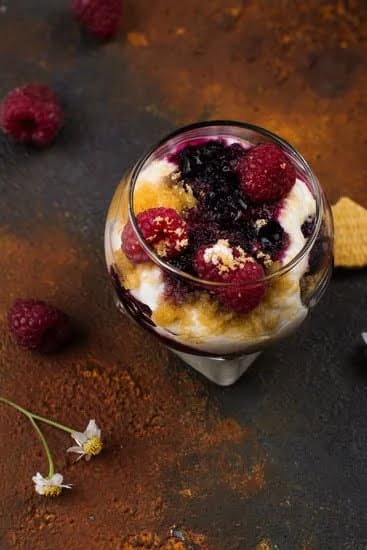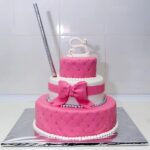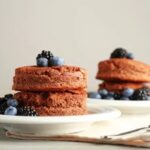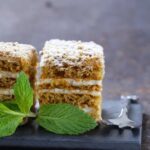Cake decorating is a culinary art that has captivated the hearts and taste buds of many. It is the practice of transforming plain cakes into stunning edible masterpieces through various techniques and tools. Whether it’s for birthdays, weddings, or other special occasions, cake decorating plays a crucial role in creating memorable experiences.
In this article, we will delve into the world of cake decorating, exploring its historical origins, key components, techniques, tools and supplies, styles and themes, as well as its importance in celebrations. We will also provide valuable tips and tricks from professionals and discuss career opportunities within this creative industry.
Cake decorating has a rich history that can be traced back centuries. What started as simple talcum powder sprinkled over cakes has evolved into intricate designs using buttercream frosting, fondant icing, piping techniques, and more. Over the years, cake decorators have pushed the boundaries of creativity to transform cakes into works of art.
The key components of cake decorating involve a combination of artistic skills and technical knowledge. Fondant serves as a versatile sculpting medium while buttercream allows for smooth finishes and vibrant colors. Piping bags with various tips enable decorators to create intricate designs such as flowers or borders. Understanding these elements is essential for anyone looking to venture into the world of cake decoration.
Cake decorating offers an array of techniques that can be learned and mastered. From basic piping methods to advanced airbrushing or sugar crafting, there is no shortage of possibilities when it comes to designing cakes. Each technique requires different tools and skills but shares the common goal of turning ordinary desserts into extraordinary creations.
Historical Origins of Cake Decorating
Cake decorating is an art that has been practiced for centuries, with its origins dating back to ancient civilizations. In this section, we will delve into the historical origins of cake decorating and trace its evolution through the years.
The Beginnings
The roots of cake decorating can be traced back to ancient Egypt, where honey was commonly used as a sweetener in baked goods. Egyptians were skillful in creating intricate designs using sugary syrups and colorful fruits to adorn their cakes. This early form of cake decoration not only added aesthetic appeal but also served as a symbol of celebration or religious significance.
The Renaissance Influence
During the Renaissance period, cake decorating took on a whole new level of sophistication and creativity. Royal families and nobles in Europe sought to impress their guests with extravagant and ornate desserts. Master bakers discovered techniques such as marzipan modeling, which involved sculpting figures out of almond paste to decorate cakes. The use of sugar paste or icing also became prevalent during this time, allowing for intricate piping work and delicate design details.
The Modern Era
In the 19th century, advancements in technology and manufacturing made cake decorating more accessible to a wider audience. Cake molds were introduced, allowing amateur bakers to create intricate shapes easily. With the invention of food coloring in the late 1800s, decorators now had vibrant hues at their disposal to enhance their designs.
The development of electric mixers and additional tools further revolutionized cake decoration techniques. From the mid-20th century onwards, buttercream frosting became widely used due to its versatility and ease of application. Fondant-a pliable icing-gained popularity for creating smooth finishes and allowing for intricate sculpting.
Today, cake decorating continues to evolve with new techniques being developed constantly. From traditional methods handed down through generations to contemporary innovations inspired by technology, the artistry behind cake decoration is truly a marvel that has stood the test of time.
Key Components of Cake Decorating
Cake decorating is an art form that involves transforming a plain cake into a beautifully crafted and visually appealing masterpiece. This section will delve into the key components and elements that are involved in cake decorating, including fondant, buttercream, piping, and other essential tools and ingredients.
One crucial component of cake decorating is fondant. Fondant is a pliable icing that can be rolled out and draped over cakes to create a smooth and flawless finish. It provides a clean canvas for intricate designs and allows decorators to achieve sharp edges and precise details. Fondant comes in various colors and can be flavored or scented to enhance the overall taste of the cake.
Another essential element of cake decorating is buttercream. Buttercream is a creamy frosting made with butter, powdered sugar, and flavorings such as vanilla or chocolate. It is commonly used to fill layers of cakes, create smooth finishes, or pipe decorative borders and designs. The versatility of buttercream allows decorators to achieve different textures, from silky smooth to rustic rosettes.
Piping is also a vital skill in cake decorating. Piping involves using a pastry bag fitted with various tips to create decorative elements such as flowers, borders, writing, and intricate designs on cakes. Different tips produce different effects, including ruffles, starbursts, leaves, shells, etc. Mastering piping techniques requires practice and precision but adds an extra level of elegance to cake designs.
In addition to these key components, there are other essential tools and ingredients used in cake decorating. These include spatulas for smoothing icing or applying coatings like ganache; turntables for easy maneuverability while decorating; offset spatulas for precise spreading; stencils for creating patterns; edible glitter or dust for sparkle; food coloring for customizing colors; and edible decorations such as pearls or sugar flowers.
| Key Components | Description |
|---|---|
| Fondant | A pliable icing that provides a smooth finish for cake designs. |
| Buttercream | A creamy frosting used for filling, smoothing, and piping on cakes. |
| Piping | The skill of using pastry bags and tips to create decorative designs. |
| Tools and Ingredients | Spatulas, turntables, stencils, food coloring, edible decorations, etc. |
Cake Decorating Techniques
Cake decorating is more than just slathering frosting on top of a cake. It involves a variety of techniques to create beautiful designs and intricate details that make a cake truly stand out. In this section, we will explore some of the most popular cake decorating techniques used by both professional bakers and home enthusiasts.
One technique that is commonly used in cake decorating is piping. Piping involves using a pastry bag fitted with a piping tip to create different shapes, patterns, and designs on the surface of a cake. This can be done using buttercream, royal icing, or even melted chocolate. Piped decorations can range from simple dots and lines to intricate floral designs and lace patterns.
Another popular technique is fondant work. Fondant is a smooth, pliable icing that can be rolled out and draped over a cake to give it a sleek and polished look. It can also be molded into various shapes and formed into intricate decorations like flowers, bows, and figures. Fondant work requires practice and patience, but the end result is often stunning.
Airbrushing is another technique that has gained popularity in recent years. With an airbrush gun, edible food coloring is sprayed onto the surface of a cake to create shading, gradients, or even realistic images. This technique allows for greater control over color intensity and can be used to achieve unique effects like watercolor or metallic finishes.
| Technique | Description |
|---|---|
| Piping | Using a pastry bag fitted with a piping tip to create different shapes, patterns, and designs on the surface of a cake |
| Fondant work | Using smooth, pliable fondant icing to cover cakes and create intricate decorations like flowers and figures |
| Airbrushing | Spraying edible food coloring onto the surface of a cake using an airbrush gun to create shading, gradients, and realistic images |
These are just a few examples of the many techniques that can be used in cake decorating. Each technique requires practice and skill to master, but with time and creativity, you can create stunning cakes that will impress anyone who sees them. In the next section, we will delve into the essential tools and supplies needed for cake decorating.
Cake Decorating Tools and Supplies
Cake decorating is not only an art form, but it also requires the right tools and supplies to bring your creations to life. Whether you are a beginner or a professional, having the essential tools and supplies is crucial for creating stunning cakes. Here is a list of some key items that every cake decorator should have in their toolbox:
Piping Bags and Tips
Piping bags are a must-have for every cake decorator. These disposable or reusable bags are used to pipe various decorations such as borders, flowers, and lettering on cakes. Along with piping bags, a collection of different tips is essential. Each tip creates a unique design, from intricate rosettes to delicate lace patterns.
Spatulas
Spatulas are versatile tools that come in different shapes and sizes. A straight spatula is perfect for spreading buttercream or ganache evenly on the cake’s surface. Offset spatulas are ideal for smoothing out buttercream and creating sharp edges on cakes.
Fondant Smoothers
Fondant smoothers help achieve that flawless finish on fondant-covered cakes. These tools enable you to smooth out any wrinkles, air bubbles, or imperfections in the fondant surface.
Rolling Pin
A rolling pin specifically designed for rolling out fondant is essential for cake decorators. The even thickness of rolled fondant ensures a uniform appearance when covering cakes.
Turntable
A turntable is a rotating stand that allows you to easily access all sides of the cake while working on it. It makes frosting and decorating more convenient and helps create professional-looking designs.
Gel Food Colors
Gel food colors provide vibrant shades without altering the consistency of icing or fondant. They are preferred by many cake decorators for their intensity and ability to mix different shades.
Edible Decorations
Edible decorations such as sprinkles, edible glitter, and edible pearls add an extra touch of sparkle and texture to your cakes. These decorations come in various shapes, sizes, and colors to suit different cake designs.
When it comes to sourcing tools and supplies for cake decorating, there are numerous options available. Specialty baking stores, online retailers, and even local craft stores often carry a wide range of cake decorating supplies. For beginners, it may be beneficial to invest in a starter kit that includes essential tools like piping bags, tips, spatulas, and a turntable.
As your skills progress and you become more comfortable with cake decorating techniques, you can expand your collection based on specific projects or designs you wish to create. Don’t forget to keep an eye out for discounts, sales, or bulk buying options that can help save money in the long run.
Having the right tools and supplies not only makes the process of cake decorating easier but also allows you to unleash your creativity with limitless design possibilities. Experiment with different tools and techniques to enhance your skills and bring your cake decorating visions to life.
Cake Decorating Styles and Themes
Cake decorating is not only about creating delicious and visually appealing cakes, but it also involves incorporating different styles and themes to make each creation unique. Whether you are a professional cake decorator or a beginner looking to try your hand at this art form, understanding the various cake decorating styles and themes can help you unleash your creativity and elevate your cake designs.
Traditional Cake Decorating Styles
One of the most popular cake decorating styles is the traditional approach. This style emphasizes the use of classic techniques such as piping intricate patterns, creating delicate sugar flowers, and using royal icing for detailed designs. Traditional cake designs often feature elegant color palettes, symmetrical shapes, and intricate borders. These timeless designs are perfect for traditional weddings, formal celebrations, and milestone birthdays.
Contemporary Cake Decorating Styles
In recent years, contemporary cake decorating styles have gained popularity. These designs focus on simplicity, clean lines, and modern aesthetics. Contemporary cakes often have a minimalist appearance with bold geometric patterns or sleek finishes. This style allows decorators to experiment with unique textures, metallic accents, and innovative techniques. Contemporary cakes are perfect for modern weddings, sleek corporate events, or anyone looking for a chic dessert option.
Themed Cake Designs
Themed cake designs have become increasingly popular as they allow decorators to create a custom cake that reflects a specific theme or interest. Themed cakes can include characters from movies or TV shows, sports-themed decorations, or even replicas of famous landmarks. The key to successful themed cake design is attention to detail and creativity in incorporating elements that capture the essence of the theme.
Customized Cake Designs
Customized cake designs are created based on the client’s individual preferences and requirements. These cakes can range from elaborate multi-tiered wedding cakes to personalized birthday cakes featuring photos or names of loved ones. Customized cakes require collaboration and communication between the client and decorator to ensure that every detail is captured perfectly.
By understanding and exploring different cake decorating styles and themes, you can find inspiration for your own creations or work with clients to bring their vision to life. Whether you prefer traditional elegance, contemporary sophistication, themed designs, or fully customized creations, there is a cake decorating style that will suit your preferences and needs. So go ahead, let your imagination run wild, and create stunning masterpieces that not only taste delicious but also showcase your unique style and creativity.
Importance of Cake Decorating in Celebrations
Cake decorating plays a significant role in celebrations and special occasions. The art of cake design has the power to enhance the overall experience and atmosphere of any event. Whether it’s a birthday, wedding, anniversary, or baby shower, a beautifully decorated cake can become the centerpiece of the celebration.
One of the key reasons why cake decorating is important in celebrations is its ability to capture the theme and mood of the occasion. Cake decorators carefully select colors, designs, and decorative elements to match the theme or purpose of the event. For example, a princess-themed birthday party may have a cake adorned with edible tiaras and sparkles, while a rustic wedding could feature a simple yet elegant buttercream-frosted cake topped with flowers.
Cake decorating also allows for personalization and customization. Many people choose to have custom cakes made for their special events, incorporating personalized details such as names, dates, or even photographs on the cake. This not only adds an extra touch of sentimentality but also makes the cake truly unique and memorable.
Furthermore, when it comes to celebrations that involve children or young adults, creative cake designs can create a sense of wonder and excitement. From character-themed cakes featuring beloved cartoon characters to gravity-defying structures that seem almost impossible to make out of cake and icing, these imaginative creations can bring joy and delight to both kids and adults alike.
Cake Decorating Tips and Tricks
Cake decorating is both an art and a science, requiring skill, precision, and creativity. As with any craft, there are always tips and tricks that can help improve your cake decorating skills and troubleshoot common issues. In this section, we will discuss some insider tips and tricks from professional cake decorators that can elevate your cake decorating game.
One important tip when it comes to cake decorating is to always start with a good foundation. This means ensuring that your cake is properly leveled, moist, and cooled before you begin the decorating process. A leveled cake provides a smooth surface for applying frostings or fondant and prevents any lopsidedness in the final design.
Another valuable trick is to use a crumb coat before applying your final layer of frosting or fondant. A crumb coat is a thin layer of frosting that helps seal in any loose crumbs on the cake’s surface. By applying a crumb coat before the final layer, you can achieve a much cleaner finish without any visible crumbs in the design.
Piping techniques are frequently used in cake decorating to create intricate designs like flowers, borders, or lettering. One helpful tip for piping is to invest in quality piping bags and tips. Cheap or low-quality piping equipment can make it difficult to control the flow of frosting and achieve precise designs. Additionally, practicing with different piping techniques on parchment paper or wax paper before attempting them on your cakes can help you perfect your skills without wasting ingredients.
By following these tips and tricks from professionals in the industry, you’ll be well on your way to becoming a master cake decorator. Remember that practice makes perfect, so don’t be discouraged if your first attempts aren’t flawless. With time and dedication, you’ll be able to create stunning cakes that delight both the eyes and taste buds of those who enjoy them.
Cake Decorating Careers and Trends
Cake decorating is not only a beloved hobby but also a thriving industry with numerous career opportunities. With the increasing popularity of custom-designed cakes, there is a high demand for skilled cake decorators. From working in established bakeries to starting their own businesses, aspiring cake decorators have various paths to pursue.
One of the most common avenues for cake decorators is working in commercial bakeries or pastry shops. These establishments often require decorators to create visually stunning cakes that appeal to customers. Additionally, many hotels and high-end restaurants hire cake decorators to design elegant, show-stopping desserts for special events and occasions.
For those who prefer a more freelance approach, opening their own cake decorating business can be a rewarding option. This allows artists to showcase their creativity and take on personalized projects such as wedding cakes or themed birthday creations. With the rise of social media platforms like Instagram and Pinterest, talented cake decorators can now reach a larger audience and gain recognition for their work.
In recent years, there has been an increase in demand for allergy-friendly or specialty cakes, such as vegan or gluten-free options. Cake decorators who specialize in these areas have found niche markets where they can cater to individuals with dietary restrictions or preferences. Staying updated on current food trends and continuously learning new techniques will enable cake decorators to meet the evolving needs of their customers.
As technology continues to advance, so does the world of cake decorating. Modern innovations such as edible printing machines and airbrushing tools have revolutionized the industry, allowing for more intricate designs and personalized touches. Keeping up with these trends by attending workshops, participating in online courses, or following industry influencers can give aspiring cake decorators an edge in this competitive field.
Whether pursuing a career as a professional cake decorator or simply enjoying it as a hobby, staying informed about current trends is vital for success within the industry. By exploring different techniques, experimenting with innovative tools, and keeping up with evolving consumer preferences, cake decorators can thrive and continue to create edible works of art.
Conclusion
Cake decorating is a truly remarkable art form that brings joy and excitement to both the creator and those who have the pleasure of enjoying the final product. Throughout history, cake decorators have honed their skills and developed innovative techniques to transform ordinary cakes into works of edible art. From the intricate designs of elaborate wedding cakes to the whimsical creations found at children’s birthday parties, cake decorating allows for endless possibilities and personal expression.
Through this article, we have explored the origins, components, techniques, tools, styles, and importance of cake decorating in celebrations. We have learned about the various elements involved in creating beautiful cakes, from fondant and buttercream to piping and other essential tools. We have gained insights into different cake decorating styles and themes, which range from traditional to contemporary and are customized based on personal preference or occasion.
Cake decorating not only adds visual appeal to any celebration but also enhances the overall experience and atmosphere of an event. Whether it is a wedding reception or a child’s birthday party, a beautifully designed cake becomes a centerpiece that captures attention and creates memorable moments. The creativity expressed through cake decorating has become an integral part of our culture’s tradition in commemorating significant milestones.
Aspiring cake decorators can benefit greatly from incorporating tips and tricks shared by professionals. Building upon foundational techniques will elevate their skills and help them troubleshoot common issues that arise during the creative process. Furthermore, with multiple career opportunities available within the industry, individuals interested in pursuing their passion for cake decorating can find fulfilling paths that enable them to showcase their artistic talents.
In conclusion, cake decorating is an art form that combines creativity with culinary skill to produce visually stunning masterpieces. Its importance goes beyond mere aesthetics; it plays a fundamental role in enhancing celebrations and creating cherished memories. With the knowledge gained from this article, readers are encouraged to explore their own creativity by trying their hand at cake decorating. Let your imagination guide you as you embrace the joy of turning a simple cake into an edible work of art.
Frequently Asked Questions
What is the meaning of cake decorating?
The meaning of cake decorating refers to the art and skill of enhancing the appearance of a cake, typically by adding various decorative elements to create a visually appealing and aesthetically pleasing dessert.
Cake decorating goes beyond simply baking and frosting a cake, as it involves techniques such as piping buttercream or royal icing, creating intricate designs, sculpting fondant or gum paste decorations, and applying various colors, textures, and patterns to transform a plain cake into an eye-catching masterpiece.
What are the 5 kinds of cake decorating?
There are five main kinds of cake decorating techniques that are commonly used by bakers and cake decorators. Firstly, there is buttercream icing, which involves using a smooth or textured layer of buttercream frosting to cover the entire cake surface. This technique allows for creative piping work and can be used to create different shapes or patterns. Fondant is another popular method where a smooth layer of rolled icing made from sugar, water, and flavorings is draped over the cake for a sleek finish.
Gum paste decorations involve molding edible clay-like dough into various shapes like flowers or figures that can be placed on top of the cake. Royal icing involves using a mixture of egg whites and powdered sugar to create piped designs or decorations that dry hard when exposed to air. Finally, there’s also chocolate ganache pouring where warm ganache is poured over the cake to achieve a luscious glossy finish.
What is the job description of a cake decorator?
The job description of a cake decorator revolves around creating visually stunning cakes through artistic skills in confectionery design. A cake decorator is responsible for baking cakes according to recipes or customer specifications while ensuring they are well-leveled and properly cooled before decoration begins. They then employ various techniques like applying icings, frostings, fondants, or glazes with precision around the entire surface of the baked goods. This may include smoothing surfaces with spatulas or scrapers before embarking on delicate detailing work such as piping intricate designs using different tips or creating fondant or gum paste decorations.
Cake decorators also need to have a keen eye for color coordination, artistic composition, and overall aesthetic appeal. In some cases, they may be required to assemble multi-tiered cakes or design specialty cakes based on custom requests. Additionally, ensuring cleanliness and following proper hygiene standards is vital throughout the decoration process.

Welcome to our cake decorating blog! My name is Destiny Flores, and I am the proud owner of a cake decorating business named Cake Karma. Our mission is to provide delicious, beautiful cakes for all occasions. We specialize in creating custom cakes that are tailored specifically to each customer’s individual needs and tastes.





